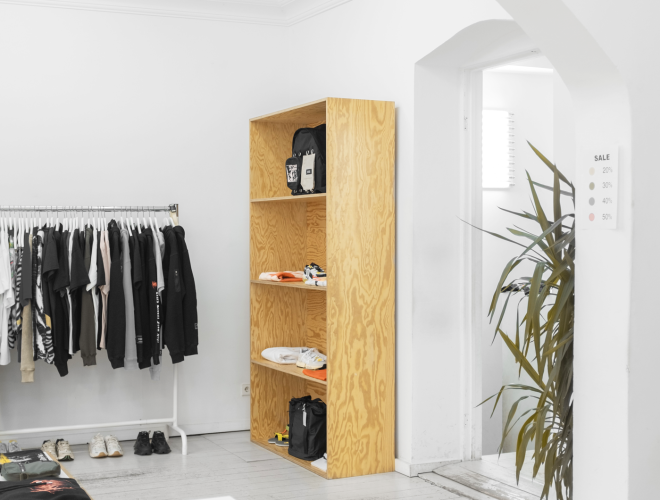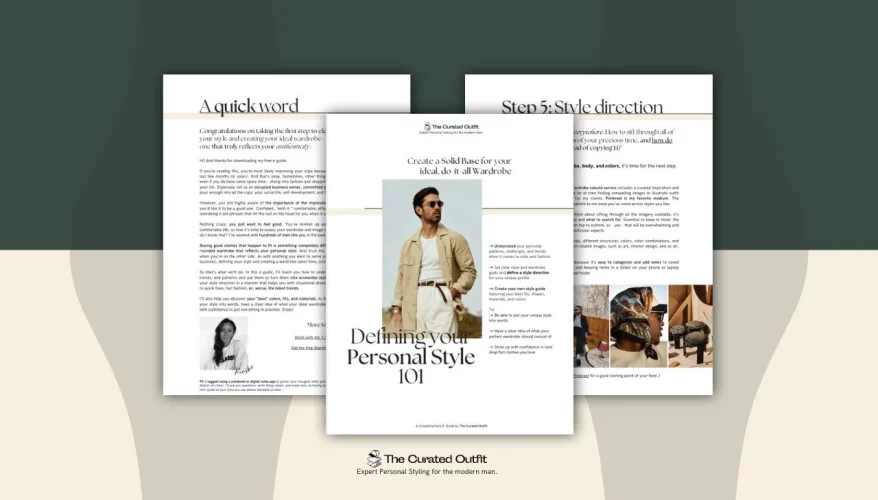AKA: new clothes.
While some renewal here and there is a great way to spice things up, new doesn’t always equal better. Especially for men who are looking to elevate their image in a budget-friendly way or those who want to breathe new life into their existing wardrobe and optimize their Personal Brand without going into too much trouble: this is for you. Today, I will teach you what I teach my clients on a highly customized and personalized level.
1: Fit at the forefront
The first thing I tell absolutely everyone, women included, is that fit comes first. Always. While plenty of (wo)men can get away with off-the-rack clothes as their perfect fit, this is only the case for some.
This results in men assuming that a specific size is ‘always’ their size. But this is simply impossible, thanks to sneaky tricks such as vanity sizing. Because of this, we tend to take those few inches of length for granted and overlook the importance of fit. Think unnecessarily rolling up pant legs when it would create a much cleaner look to have them shortened.
Not only that, but we prefer to roll up sleeves rather than have them adjusted, and if a T-shirt is too short, we often settle for taking one size up (and too wide) to achieve the right length.
Embrace your local tailor’s craftsmanship
Teaming up with your local tailor means you don’t have to settle for less. And you shouldn’t want to because wearing the proper fit will, in 99% of cases, solve that familiar sense of something being off. Trust me – you’re not the only one noticing if something doesn’t just fit right or feels right; your surroundings can often tell, too.
And before you take that big sigh, get this. You’re not the only guy immediately feeling a figurative sense of pain while hearing the word ‘tailor.’ Many men do, for reasons unknown to me. Maybe it’s because we’re programmed to assume that tailoring and adjusting clothes is a luxury reserved (still) only for the wealthy.
However, we’re in 2023, and I’m here to debunk that myth. In case your sigh was out of laziness: get this: if you want cheap thrills, you must invest time instead of money.
Action point: take another look at that set of clothes in the back of your wardrobe or those items that feel “just off” (but wear anyway) and determine if the fit is the only issue. If it is, visit your local tailor to work with them to fix it.
2: Master the art of Situational Dressing
Mastering situational dressing is one of the most important chapters of Menswear 101. In daily life, this all comes down to knowing how to dress appropriately at different events. This essential skill has become even more critical as dress codes have gotten a more relaxed approach in the corporate world. Now, failing to adapt your outfit to match the occasion may limit your ability to close important deals.
As a solution, businesses worldwide seek the expertise of corporate stylists to provide guidance on the best attire for specific meetings. If your business doesn’t belong to the lucky ones or you’re ready to apply situational dressing throughout the rest of your life, too (equally as necessary), read on.
Leveling with the other side of the table
To excel in situational dressing, it’s crucial to read the room and connect with your clients, business associates, or simply the setting and people around you (outside of work). A common pitfall to avoid, especially in corporate meetings, is dressing too formally: think being a corporate lawyer showing up in a suit and tie at the first meeting with a marketing agency as your prospect.
This can suggest a lack of adaptability. But on the other hand, dressing too casually can appear unprofessional. Here, a semi-formal look consisting of a more casual suit or suit separates, and a clean-looking long-sleeve polo shirt will do. You’re here to practice the law, after all.
The ground rules x your aesthetic preferences = success
The best way to determine what to wear on what occasion is simple. In any company or there are ground rules. Such as that same lawyer in court showing up in a suit and creative agency owners mostly wearing what they want but avoiding the common flip-flops-and-shorts debacle at all costs.
70% comes down to common sense, with 30% left for figuring out ways to express your personality – even when it seems situational dressing is just another way of limiting your sartorial options. It’s not. There’s enough room to express your personal style preferences throughout.
Sitting on the other side of the table from that corporate lawyer – being the agency creative – you might want to step up your regular game. Still, you could wear those newly purchased sneakers from Common Projects, but you will probably swap your sweatshirt and jeans for a casual shirt and tailored trousers. Get the point?
Both our professional and private life deserve equal attention. That’s why you can (and should) apply situational dressing in all areas of your life by recognizing how your clothing impacts your environment and choosing the right outfit accordingly. Whether going on a date or running a marathon, dressing appropriately for the occasion is vital. After all, you won’t go on a date in the same outfit as you’re going to run a marathon, right?
3: Details aren’t just details
It’s not just me being passionate about my job when I say clothing is more than just clothing. Every decision you make when it comes down to your clothes conveys something – more than you think. Let me explain.
The width of your tie and shirt collar
What can often cause a disbalance in your look is a shirt collar width and tie that doesn’t lie in proportion with your physical features. In my opinion, skinny ties and shirt collars generally convey an inexpensive, youthful look, so these are best to avoid for important occasions.
When you’re on the larger, broader hand, your best bet is to opt for a tie width between 8 and 9.55 cm. The average shoulder width for a man is around 50 cm. In most cases, ties with a width of 8 cm are your perfect fit.
Ready-to-wear isn’t always ready to wear
If you’ve recently bought new clothes and can’t wait to wear them, you should know a few things before you do.
- Jacket vents are supposed to be cut open. The only reason they’re closed when purchasing them is for your garments to stay in shape during production and transport.
- Sleeve labels on jackets are not here to show off with. That nice-looking, luxury sleeve label with the brand of your new jacket needs to go. Because this label is made of fabric, most people think they are simply part of the suit. But no: the tag is purely meant to make the brand visible to a retailer when hung up on a rack between suits of different brands.
- Keep a sleek line of your jacket by leaving the pockets closed. You can open them (it’s what you officially should do), but to keep your jacket in better shape, I usually leave the pockets closed. The only downside is that your pockets will be useless – which is good. I assume you won’t carry your bulky wallet or phone in it anyway…
Grooming
Excellent grooming is the most crucial step towards looking good in your clothes, apart from your actual clothing. The best groomed among us have the ability to pay great attention to detail in other areas, too. Messy, disorganized dressers are typically judged poorly compared to their neat colleagues.
Let’s put it simply: a man with well-groomed facial hair (including your nose and ears, please), clean, cut nails, and a good haircut will always leave a good impression. And keep in mind that more isn’t always better when it comes down to deodorant and perfume.
How you care for your clothes
If you’ve invested money in your wardrobe, the least you can do is take care of it.
- Use wooden hangers for your (dress) shirts and hang them about 1 to 2 cm apart;
- Steam or iron your clothes to avoid leaving the house with a sloppy look;
- Use shoe trees for your best shoes;
- Have your suits dry-cleaned;
- Wash your clothes regularly, but don’t overdo it;
- Hang knitwear the right way or store them folded;
- Polish your shoes.
Washing labels are here for a reason: always check them. That occasional trip to the dry cleaners is worth it, and cold wash is usually fine for nearly everything. A good rule to remember is that most clothing doesn’t get worn out by you wearing it; It gets worn out by you washing it. How often should you wash your clothes? Yep, that’s also something I’d love to teach you.
Need help? Consider teaming up with a Personal Stylist.
Do the clothes you own simply don’t represent your personal brand anymore? Let’s change that and get you to look your best on any occasion, effortlessly. Book your Personal Styling session here.


